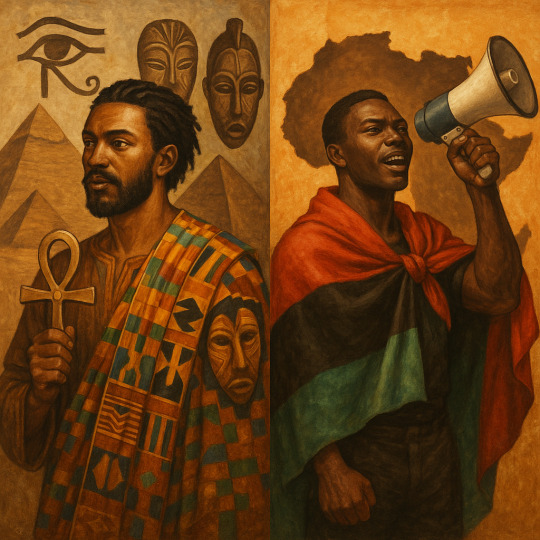my world of color is a stage for my idea of the beautiful, the erotic, and the essential.
Last active 60 minutes ago
Don't wanna be here? Send us removal request.
Text

Roots and Routes: The Sharp Divide Between Afrocentrism and Pan-Africanism Through a Garveyite Lens
Introduction:
Too often in today’s discourse, Pan-Africanism and Afrocentrism are used interchangeably. But from a Garveyite perspective—rooted in organization, political power, race-first philosophy, and global Black unity—this conflation is both incorrect and dangerous. While both frameworks attempt to restore dignity to African people, their core philosophies, strategies, and end goals differ profoundly. One is a worldview rooted in aesthetic restoration and cultural reclamation; the other is a revolutionary project of global liberation, nation-building, and self-determination. Let’s draw the line.
1. Definitions: Surface vs Structure
Afrocentrism is primarily an intellectual and cultural movement. It seeks to reframe history, philosophy, and identity from an African-centered perspective. It reclaims ancient African contributions to civilization (Kemet, Nubia, etc.), reinterprets historical narratives, and critiques Eurocentric frameworks in education, religion, and science. Its goal is to mentally decolonize.
Pan-Africanism, especially in its Garveyite form, is a political movement—built on race pride, economic independence, self-reliance, and the unification of all African people under one flag. It calls for African control of African affairs, be it on the continent or in the diaspora. It doesn’t just want to rewrite history—it wants to make history.
Garveyism, the most militant and organized strand of Pan-Africanism, understands this difference and demands more than mental liberation. It demands power—political, economic, and military.
2. Cultural Reconnection vs Political Realignment
Afrocentrism often revolves around symbolic reclamation—names, clothes, spiritual systems, and a sense of identity. It’s about replacing European heroes with African ones, reclaiming ancestral memory, and taking pride in Blackness.
But Pan-Africanism asks: What systems do we control? Who governs our lands? Who owns the resources? It sees cultural pride as a tool, not an endpoint. Garveyites assert: What good is reclaiming a name or deity if we still live under foreign rule, economic dependency, and systemic subjugation?
Afrocentrism may critique oppression. Pan-Africanism strategizes to end it.
3. Individual Liberation vs Collective Nationhood
Afrocentrism often emphasizes personal or group enlightenment—an internal transformation through African-centered knowledge and spirituality. While powerful, this path often lacks organized mass movement or material outcomes.
Garveyite Pan-Africanism is inherently collectivist. It calls for global Black unity—not just in spirit but in institution. Garvey’s UNIA (Universal Negro Improvement Association) built shipping lines, schools, factories, newspapers, and provisional governments. The aim wasn’t just consciousness—but sovereignty.
Afrocentrism may change minds. Pan-Africanism changes conditions.
4. Diaspora Focus vs Global Black Nation
Most Afrocentric discourse is diaspora-centric, particularly African American in tone. Its critiques and solutions are often local, focused on Western systems of education, religion, and media.
Pan-Africanism—Garveyite Pan-Africanism especially—is transnational. It refuses to center the West. It sees Black people in America, the Caribbean, Africa, and Europe as one people with one destiny. Its map is global. Its aim is a worldwide African federation.
Garvey said: “Africa for the Africans, at home and abroad.” Afrocentrism too often forgets the abroad is not just where we are, but where we must unite to return, rebuild, and reign.
5. Militancy and Mass Movement
Garveyism believes Black liberation is a war. It’s not poetic or symbolic—it’s real. It demands discipline, order, strategy, and mass mobilization. The UNIA was a blueprint: uniforms, oaths, ranks, black cross nurses, and political offices. That wasn’t cosplay—it was preparation for sovereignty.
Afrocentrism is rarely militant. It is more academic, introspective, and expressive. There is no Afrocentric equivalent to the UNIA or the Black Star Line. No global organizational machinery. No chain of command. No flag to fight under.
Garveyites know that without structure, you cannot build power.
6. Pitfalls of Afrocentrism: The Garveyite Warning
Myth-making without organizing: Afrocentrism sometimes indulges in unverified or romanticized histories (e.g., everyone being Moors, Israelites, or Pharaohs), which can become distractions.
Individualism over institution: It often produces lectures, not organizations.
Confusion over unity: It can fracture along spiritual lines—Kemetic, Yoruba, Moorish, etc.—while Pan-Africanism aims to unify across these differences for political goals.
Silence on Africa today: Many Afrocentrists romanticize ancient Africa but have little to say about modern Africa’s struggles or Pan-African state-building efforts.
Garveyism stands firm: If it does not build power for African people worldwide—it’s not enough.
Conclusion: The African Race Needs Builders, Not Just Dreamers
Afrocentrism is not the enemy of Pan-Africanism—but it is not the substitute. Culture without sovereignty is performance. Identity without power is vulnerability. Garveyism demands we go beyond aesthetic reconnection and move toward global Black reconstruction.
As Garvey once thundered: “The Black man must build for himself. If others are to live by conquering, then he too must learn to conquer for his survival.”
Let us not be content dressing in Kente while begging for crumbs. Let us organize, unify, and take what is ours.
89 notes
·
View notes
Photo


Leon, NYC, 28 Photographer : Alejandro Garcia Ig: kiingleon
3K notes
·
View notes














